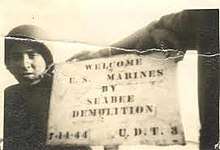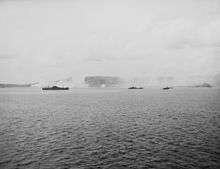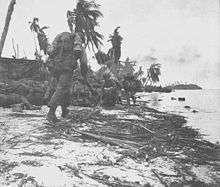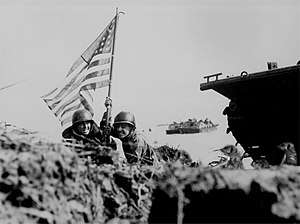Battle of Guam (1944)
The Second Battle of Guam (21 July – 10 August 1944) was the American recapture of the Japanese-held island of Guam, a U.S. territory in the Mariana Islands captured by the Japanese from the U.S. in the 1941 First Battle of Guam during the Pacific campaign of World War II.
Background
Guam, at 212 square miles (543 square kilometers), is the largest island of the Marianas, with a length of 32 miles (52 km) and a width ranging from 12 miles (19.31 km) to four miles (6.44 km) at different points of the island.[4][1]: It had been a United States possession since its capture from Spain in 1898 until it was captured by the Japanese on 10 December 1941, following the attack on Pearl Harbor. It was not as heavily fortified as the other Mariana Islands such as Saipan that had been Japanese possessions since the end of World War I, but by 1944, Guam had a large Japanese garrison.
The Allied plan for the invasion of the Marianas, Operation Forager, called for heavy preliminary bombardment, first by carrier aircraft and USAAF bombers based in the Marshall Islands to the east, then once air superiority was gained, close bombardment by battleships, cruisers, and destroyers.[1]:22 Saipan, Tinian, and Guam were chosen as the targets due to their size, their suitability as a base for supporting the next stage of operations toward the Philippines, Taiwan, and the Ryukyu Islands; and the seaport at Apra Harbor was suitable for the largest ships; and air bases for Boeing B-29 Superfortresses could be built from which to bomb Japan. B-24 Liberators from the Marianas could also bomb Iwo Jima and the Bonin Islands, such as Chichi Jima.[1]:22
The invasion of Saipan was scheduled for 15 June 1944, with landings on Guam tentatively set for 18 June.[1]:22 The original timetable was optimistic, however. A large Japanese carrier attack and stubborn resistance by the unexpectedly large Japanese garrison on Saipan led to the invasion of Guam being postponed for a month.[1]:25
U.S. naval and air bombardments lasted from 11–13 June 1944, involving 216 carrier aircraft and land-based B-24 bombers from the Marshall Island. On the 12th and 13th of the month, 12 Japanese cargo ships and several fishing vessels were sunk. On June 27, U.S. Navy battleships and cruisers started shelling the island, joined by a U.S. carrier group on 4 July, and two more on 6 July.[1]:42
Battle




Guam, ringed by reefs, cliffs, and heavy surf, presents a formidable challenge for any attacker.[1]:14 Underwater demolition teams reconnoitered the beaches and removed obstacles from 14–17 July.[1]:43 Despite the obstacles, on 21 July, the American forces landed on both sides of the Orote Peninsula on the western side of Guam, planning to secure Apra Harbor.[1]:23 The 3rd Marine Division landed near Agana to the north of Orote at 08:29, and the 1st Provisional Marine Brigade landed near Agat to the south.[1]:24,44 Japanese artillery sank 20 U.S. LVTs and inflicted heavy casualties on the landing troops, especially of the 1st Provisional Marine Brigade, but by 09:00 Marines and tanks were ashore at both beaches.
By nightfall, the U.S. Marines, and soldiers of the 77th Infantry Division had established beachheads about 6,600 feet (2,000 m) deep.[5] Japanese counterattacks were made throughout the first few days of the battle, mostly at night, using infiltration tactics. Several times the Japanese penetrated the American defenses and were driven back with heavy losses of men and equipment.
The U.S. Army's 77th Infantry Division had a more difficult landing on 23–24 July.[1]:17 Lacking amphibious vehicles, they had to wade ashore from the edge of the reef where the landing craft dropped them off. The men stationed in the two beachheads were pinned down by heavy Japanese fire, making initial progress inland quite slow. Supply was very difficult[6] for the landing troops on Guam in the first days of the battle. Landing ships could not come closer than the reef, several hundred yards from the beach, and amphibious vehicles were scarce.
The 1st Provisional Brigade blocked off the Orote Peninsula on 25 July, and that same night Japanese Lt. General Takashina counterattacked, coordinated with a similar attack against the 3rd Division to the north.[1]:56 The next day, General Obata reported, "our forces failed to achieve the desired objectives."[1]:61 Lieutenant General Takeshi Takashina was killed on 28 July, and Lieutenant General Hideyoshi Obata took over the command of the Japanese defenders.[1]:65 On 28 July, the two beachheads were linked,[1]:17 and by 29 July, the Americans secured the peninsula.[1]:64
The Japanese counterattacks against the American beachheads, as well as the fierce fighting, had exhausted the Japanese. At the start of August, they were running out of food and ammunition, and they had only a handful of tanks left. Obata withdrew his troops from southern Guam, planning to make a stand in the mountainous central and northern part of the island, "to engage in delaying action in the jungle in northern Guam to hold the island as long as possible".[1]:65
After ensuring that no significant Japanese forces operated in the southern portion of Guam, Marine Major General Geiger started an offensive north with the 3rd Marine Division on the left flank, and the 77th Infantry Division on the right, liberating Agana on the same day.[1]:70 The Tiyan Airfield was captured on 1 Aug.[1]:72
Rain and thick jungle made conditions difficult for the Americans, but after an engagement with the main Japanese line of defense around Mount Barrigada from 2–4 August, the Japanese line collapsed.[1]:73–74 The 1st Provisional Brigade formed up on the left flank of the 3rd Marine Division on 7 August because of the widening front and continued casualties, in an effort to prevent the Japanese from slipping through the American gaps.[1]:75–76 The Japanese had another stronghold at Mount Santa Rosa, which was secured on 8 Aug.[1]:74,81
On 10 August, organized Japanese resistance ended, and Guam was declared secure, but 7,500 Japanese soldiers were estimated to be at large.[1]:81 The next day, Obata committed ritual suicide at his headquarters on Mount Mataguac after he had sent a farewell message to Japan.[1]:81
Aftermath

A few Japanese soldiers held out in the jungle after the fighting on Guam.[1]:87 On 8 December 1945, three U.S. Marines were ambushed and killed. On 24 January 1972, Japanese Army Sergeant Shoichi Yokoi was discovered by hunters on the island. He had lived alone in a cave for 28 years, near Talofofo Falls.
Guam was turned into a base for Allied operations after the battle. Five large airfields were built by the Navy Seabees, and Army Air Forces B-29 bombers flew from Northwest Field and North Field on Guam to attack targets in the Western Pacific and on mainland Japan.[1]:87–88
Liberation Day continues to be celebrated on Guam every July 21.
Order of Battle
United States
Expeditionary Troops
- Commanding General: Lieutenant General Holland M. Smith
- Chief of Staff: Brigadier General Graves B. Erskine
- Personnel Officer (G-1): Lieutenant Colonel Albert F. Metze
- Intelligence Officer (G-2): Colonel St. Julien R. Marshall
- Operations Officer (G-3): Colonel John C. McQueen
- Logistics Officer (G-4): Colonel Raymond E. Knapp
- Plans Officer (G-5): Colonel Joseph T. Smith
- Chief of Staff: Brigadier General Graves B. Erskine
Southern Troops and Landing Force
- Commanding General: Major General Roy S. Geiger
- Chief of Staff: Brigadier General Merwin H. Silverthorn
- Personnel Officer (C-1): Colonel William J. Scheyer
- Intelligence Officer (C-2): Lieutenant Colonel William F. Coleman
- Operations Officer (C-3): Colonel Walter A. Wachtler
- Logistics Officer (C-4): Lieutenant Colonel Frederick L. Wieseman
- Chief of Staff: Brigadier General Merwin H. Silverthorn
Subordinate units
III Marine Amphibious Corps Artillery
- Commanding General: Brigadier General Pedro del Valle
- Chief of Staff : Colonel John A. Bemis
- Personnel Officer (A-1): Major James A. Tatsch
- Intelligence Officer (A-2): Warrant Officer David G. Garnett
- Operations Officer (A-3): Lieutenant Colonel Frederick P. Henderson
- Logistics Officer (A-4): Major Frederick W. Miller
- Chief of Staff : Colonel John A. Bemis
1st 155mm Howitzer Battalion
- Commanding Officer: Colonel James J. Keating
- Executive Officer: Major George H. Ford
- Operations Officer (Bn-3): Major Marshall J. Hooper
2nd 155mm Howitzer Battalion
- Commanding Officer: Lieutenant Colonel Marvin H. Floom
- Executive Officer: Major Gene N. Schraeder
- Operations Officer (Bn-3): Major Earl J. Fowse
- Commanding Officer: Lieutenant Colonel Archie E. O'Neil
- Commanding Officer: Lieutenant Colonel William F. Parks
- Commanding General: Major General Allen H. Turnage
- Assistant Commander: Brigadier General Alfred H. Noble
- Chief of Staff: Colonel Ray A. Robinson
- Personnel Officer (D-1): LtCol Chevey S. White (KIA 22J); Maj Irving R. Kriendler (From 22J)
- Intelligence Officer (D-2): LtCol Howard J. Turton (To 28J); LtCol Ellsworth N. Murray (From 29J)
- Operations Officer (D-3): Colonel James A. Stuart (To 28J); LtCol Howard J. Turton (From 29J)
- Logistics Officer (D-4): LtCol Ellsworth N. Murray (To 28J); Col William C. Hall (From 29J)
3rd Service Battalion
- Commanding Officer: LtCol Durant S. Buchanan
3rd Tank Battalion
- Commanding Officer: LtCol Hartnoll J. Withers
- Commanding Officer: Colonel William C. Hall (To 28J); Colonel James A. Stuart (From 29J)
- Executive Officer: Colonel James D. Snedeker
- Commanding Officer: Major Henry Aplington, II
- Executive Officer: Major John A. Ptak (KIA 1A)
- Commanding Officer: LtCol Hector de Zayas (KIA 26J); Maj William A. Culpepper (From 26J)
- Executive Officer: Maj William A. Culpepper (To 26J); Maj Howard J. Smith (From 26J)
- Commanding Officer: LtCol Ralph L. Houser (WIA 22J); Maj Royal R. Bastian (From 24J)
- Executive Officer: Maj Royal R. Bastian (To 23J); Capt William R. Bradley (From 24J)
- Commanding Officer: Col Edward A. Craig
- Executive Officer: LtCol Jaime Sabater (WIA 21J); LtCol Ralph M. King (From 30J)
- Commanding Officer: LtCol Carey A. Randall
- Executive Officer: Maj Harold C. Boehm
- Commanding Officer: LtCol Robert E. Cushman, Jr.
- Executive Officer: Maj William T. Glass
- Commanding Officer: LtCol Walter Asmuth, Jr. (WIA 21J); Maj Donald B. Hubbard (WIA 1A); Maj Jess P. Ferrill, Jr. (From 1A)
- Executive Officer: Maj Donald B. Hubbard (To 22J); Capt Calvin W. Kunz, Jr. (From 22J)
- Commanding Officer: Col Arthur H. Butler
- Executive Officer: LtCol Ernest W. Fry, Jr.
1st Battalion, 21st Marines
- Commanding Officer: LtCol Marlowe C. Williams
- Executive Officer: LtCol Ronald R. Van Stockum
2nd Battalion, 21st Marines
- Commanding Officer: LtCol Eustace R. Smoak
- Executive Officer: Maj Lowell English
3rd Battalion, 21st Marines
- Commanding Officer: LtCol Wendell H. Duplantis
- Executive Officer: Maj Edward A. Clark
12th Marine Artillery Regiment
- Commanding Officer: Col John B. Wilson
- Executive Officer: LtCol John S. Letcher
- Commanding Officer: LtCol Raymond F. Crist Jr. (WIA 22J) *
- Executive Officer: Maj George B. Thomas
2nd Battalion, 12th Marines
- Commanding Officer: LtCol Donald M. Weller
- Executive Officer: Maj Henry E. W. Barnes
- Commanding Officer: LtCol Alpha L. Bowser
- Executive Officer: Maj Claude S. Sanders, Jr.
4th Battalion, 12th Marines
- Commanding Officer: LtCol Bernard H. Kirk (WIA 21J) *
- Executive Officer: Maj Thomas R. Belzer
- Commanding Officer: LtCol Robert E. Fojt
- Executive Officer: LtCol Edmund M. Williams
1st Provisional Marine Brigade
- Commanding General Brigadier General Lemuel C. Shepherd Jr.
- Chief of Staff: Colonel John T. Walker
- Personnel Officer (B-1): Maj Addison B. Overstreet
- Intelligence Officer (B-2): Maj Robert W. Shaw
- Operations Officer (B-3): LtCol Thomas A. Culhane, Jr.
- Logistics Officer (B-4): LtCol August Larson
- Chief of Staff: Colonel John T. Walker
- Commanding Officer: LtCol Alan Shapley
- Executive Officer: LtCol Samuel D. Puller (KIA 27J); Capt Charles T. Lamb (From 27J)
- Commanding Officer: Maj Bernard W. Green
- Executive Officer: Maj Robert S. Wade (temp. atchd.)
- Commanding Officer: Maj John S. Messer
- Executive Officer: Maj Roy S. Batterton, Jr. (WIA 21J); Capt Lincoln N. Holdzcom (From 21J)
- Commanding Officer: Maj Hamilton M. Hoyler
- Executive Officer: Maj Hugh J. Chapman
- Commanding Officer: Col Merlin F. Schneider
- Executive Officer: LtCol William J. Wise
1st Battalion, 22nd Marines
- Commanding Officer: LtCol Walfried H. Fromhold (To 31J); Maj Crawford B. Lawton (From 1A)
- Executive Officer: Maj Crawford B. Lawton (To 1A); Maj William E. Sperling, III (From 5A)
2nd Battalion, 22nd Marines
- Commanding Officer: LtCol Donn C. Hart (To 27J); Maj John F. Schoettel (WIA 27J) *
- Executive Officer: Maj Robert P. Felker
3rd Battalion, 22nd Marines
- Commanding Officer: LtCol Clair W. Shisler (WIA 27J) *
- Executive Officer: Maj Earl J. Cook
- Commanding General: Major General Andrew D. Bruce
- Assistant Division Commander: Brigadier General Edwin H. Randle
- Chief of Staff: Col Douglas C. McNair (KIA 6A); LtCol Guy V. Miller (From 6A)
Guam Island Command
- Commanding General: Major General Henry L. Larsen
- Chief of Staff: Col Robert Blake
- Personnel Officer (A-1): Col Lee N. Utz
- Intelligence Officer (A-2): Col Francis H. Brink
- Operations Officer (A-3): Col Benjamin W. Atkinson (To 8A); LtCol Shelton C. Zern (From 9A)
- Logistics Officer (A-4): Col James A. Mixson
- Plans Officer (A-5): Col Charles I. Murray
- Chief of Staff: Col Robert Blake
1st Provisional Base Headquarters Battalion
- Commanding Officer: LtCol Victor A. Barraco
- Headquarters Company: 1stLt Emerson S. Clark, Jr.
- Military Police Company: Capt Paul J. Swartz
5th Field Depot
- Commanding Officer: LtCol Walter A. Churchill
- Executive Officer: LtCol Patrick J. Haltigan, Jr.
- Operations Officer: Maj John W. Allen
Japan
- Commander: General Hideyoshi Obata
- Commander: Lieutenant general Takeshi Takashina
- 18th Inf. Regiment
- 38th Inf. Regiment
- Commander: Lieutenant General Toshimoto Hoshino
- 9th Tank Regiment
- 48th Ind. Brigade
- 10th Ind. Mixed Reg.
- 319th, 321st, 322nd, 820th Independent Infantry Battalions
Unit awards
- 1st Provisional Marine Brigade, 21 July to 10 August 1944.
Medal of Honor recipients
Four Medal of Honor recipients of the Battle of Guam:
- Captain (later General) Louis H. Wilson, Jr., USMC
- Private First Class Leonard F. Mason, USMC (posthumous)
- Private First Class Luther Skaggs Jr., USMC
- Private First Class Frank Witek, USMC (posthumous)
See also
- 18th Infantry Regiment (Imperial Japanese Army)
- Agana race riot – Violent confrontation between white U.S. Marines and black U.S. sailors
- Battle of Guam (1941)
- Pacific War Museum
- Return to Guam, 1944 documentary and propaganda film about the battle
- The War in the Pacific National Historical Park
- George Ray Tweed
- Nimitz Hill
References
- 1 2 3 4 5 6 7 8 9 10 11 12 13 14 15 16 17 18 19 20 21 22 23 24 25 26 27 28 29 Rottman, G. (2004). Guam 1941 & 1944: Loss and Reconquest. Oxford: Osprey Publishing. ISBN 9781841768113.
- ↑ Taki, THE HISTORY OF BATTLES OF IMPERIAL JAPANESE TANKS.
- ↑ "Casualty List - U.S. Armed Forces - 1944". National Park Service, War in the Pacific National Historical Park, Guam. Retrieved 8 March 2017.
- ↑ "Guam's Geography at ns.gov.gu". ns.gov.gu. Retrieved 2016-05-02.
- ↑ Gailey (1988), pp.90–112.
- ↑ Video: Allies Study Post-War Security Etc. (1944). Universal Newsreel. 1944. Retrieved 21 February 2012.
Further reading
- Anderson, Charles R. Western Pacific. U.S. Army Campaigns of World War II. United States Army Center of Military History. CMH Pub 72-29.
- Gailey, Harry (1988). The Liberation of Guam 21 July – 10 August. Novato, California, U.S.A.: Presidio Press. ISBN 0-89141-651-X.
- Guam: Operations of the 77th Division. American Forces in Action series. United States Army Center of Military History. 1990 [1946]. CMH Pub 100-5.
- Hatashin, Omi (2009). Private Yokoi's War and Life on Guam, 1944–72: The Story of the Japanese Imperial Army's Longest WWII Survivor in the Field and Later Life. Honolulu: University of Hawaii Press. ISBN 1-905246-69-2.
- Manchester, W., 1980, Goodbye, Darkness: A Memoir of the Pacific War, Boston: Little, Brown, and Co., ISBN 978-0-316-54501-3, pp 278–302
External links
| Wikimedia Commons has media related to Battle of Guam. |
- Battle for the Mariana Islands on YouTube
- "The Marianas and the Great Turkey Shoot", World War II Database.
- Lodge, Major O.R. USMC Historical Monograph: The Recapture of Guam, Historical Branch, United States Marine Corps, 1954.
- O'Brien, Cyril J. Liberation: Marines in the Recapture of Guam, Marines in World War II Commemorative Series, Marine Corps Historical Center, United States Marine Corps, 1994.
- Dyer, George Carroll (1956). "The Amphibians Came to Conquer: The Story of Admiral Richmond Kelly Turner". United States Government Printing Office. Archived from the original on 21 May 2011. Retrieved 5 May 2011.
- Keene, R.R. "Wake up and die, Marine!". Leatherneck Magazine.
- Photos from the Liberation of Guam The Real Revo
- A film clip Allies' Study: Post-War Security, etc. (1944) is available at the Internet Archive
- Pacific War Museum National Park Service site
Coordinates: 13°22′09″N 144°39′03″E / 13.3693°N 144.6509°E
